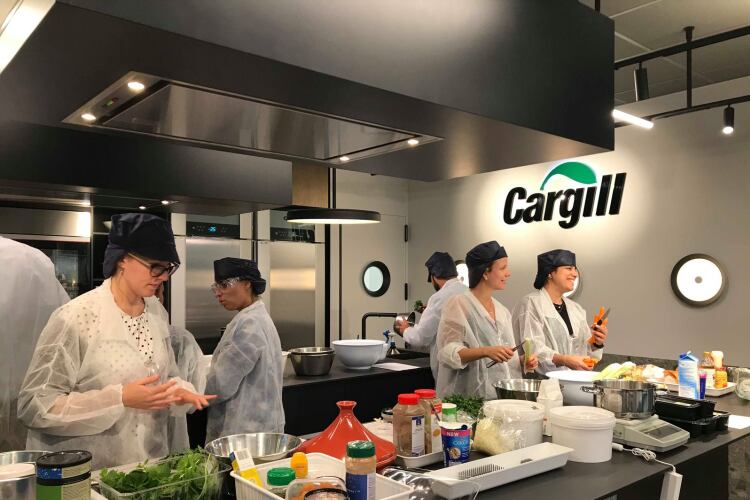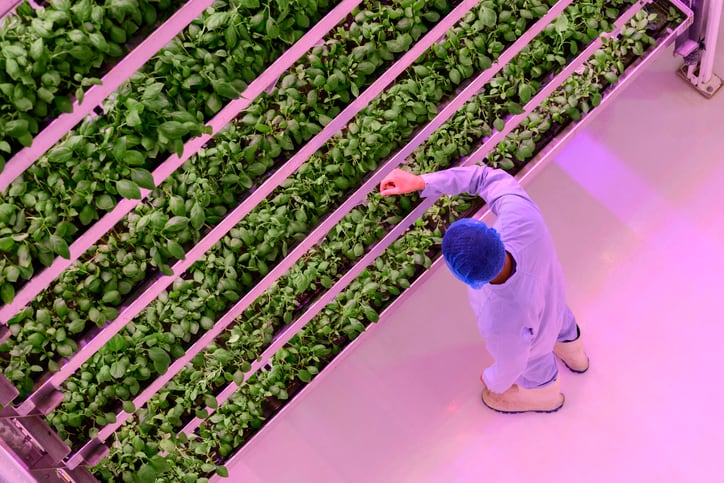Florian Schattenmann joined Cargill as chief technology officer and VP of R&D four years ago. He made the jump from the chemicals sector, having most recently held leadership positions at The Dow Chemical Company.
The R&D expert – who has worked in Fortune 500 companies and start-ups alike – was attracted to the food industry because of a transformation he saw taking place. “There’s been an explosion of innovation in the market,” he told FoodNavigator, pointing to the ‘well over’ 30,000 start-ups in food and ag tech – a level that was ‘unthinkable’ a few short years ago.
This is being supported by an influx of capital into innovative start-ups. Schattenmann reflected that food sector venture capital deal volume in 2013 stood at around US$2.3bn. Last year, that figure totalled $30bn. And in the first-half of 2021 deal value amounted to $24bn, suggesting further acceleration still. “The growth rate is enormous. There's no other industry that does that right now.”
This is resulting in a ‘period of disruption’ – but one that Cargill’s innovation lead says is also ‘a period of opportunity’ for the US’s largest privately-owned company. Not having to report to shareholders on a quarter-by-quarter basis frees Cargill’s hand to look at ‘a couple of longer-term investments’.
Four ‘fundamental’ drivers of change
Schattenmann believes that four ‘fundamental drivers’ have sparked this game-changing level of innovation in the food sector, creating the ‘perfect storm’ for an industry ripe for disruption.
Cargill’s R&D head subscribes to a generational theory of change that sees a new cohort of young consumers bringing fresh approaches to what and how they eat. “The generation of my daughters’ is one that is very open to try new things… This idea around alternative this, alternative that. Consumer behaviour is for sure changing,” he observed.
The R&D expert also noted a ‘much higher consciousness around health and immunity’. “You are what you eat is more and more at the forefront. Health benefits are going to be much more important.”
Schattenmann pinpoints sustainability as a core value spurring innovation. “I would say five, ten years ago, the quote-unquote bad guys [in the discussion around sustainability] were the energy industry, the transportation industry, maybe the chemicals industry. All of a sudden, the light was shone on how sustainable are these ag practices around the world?”

Consumers and businesses alike have switched on to the importance of developing a more sustainable food system. For Cargill, this means embedding sustainability into the NPD process.
“Whenever you introduce a new process or a new product that's an opportunity to do things better. In the past, when we said better, it typically had two elements - a higher performance, a lower cost at the same performance, or both.
“Now we say there's a third arm. It also has to be more sustainable. And it has to be more sustainable by some sort of quantitative measure. We are now putting that third dimension into the innovation process.”
Cargill’s R&D department has added a qualitative sustainability module to its ideation process. At the end of the process, before commercialisation, the innovation undergoes a qualitative assessment to look at its footprint. “If it is going to have a negative effect then we won’t bring that solution forward,” Schattenmann revealed.
Finally, the technology chief observed, advances in science and tech are providing the sector with cost-effective tools to develop new products and ways of working that answer these challenges.
“The fourth driver, this may be one of the most important ones, is that new technologies have entered a realm where they become cost effective. We call that hyper acceleration. It's all driven by digital fundamentally, but you see what's happening in biotechnology, you see what's happening in artificial intelligence, you see what's happening in robotics, bioinformatics, ingredient informatics. All of these things that were all esoteric and super cool but not really that relevant, they have been accelerating and have become cheaper at a massively fast pace.
“When you take a cell-based burger and it's $300,000 to make that one burger, people find that a curiosity. But now we have seen cost come down to where it's still way too expensive, but I could see it from my house, like it's coming.”
These cost curves are vital from an R&D perspective because at some point ground-breaking technologies become cheap enough that they reach a tipping point.
Backing the winners
High levels of capital coming into the sector are certainly supporting elevated levels of innovation. But, at some point, there will be technological winners and losers. The VHSs and Betamaxs of the world. So, how does Cargill’s R&D department ensure it is backing the right horses?
The ingredient giant is changing its ‘view of how to participate’ in response to this challenge, Schattenmann responded.
In the past, a large player like Cargill would identify an opportunity, start a conceptual project, do the stage-gate processes and move along. “That has two disadvantages. First of all, it's not very fast because you have to go through every stage gate and so on. The other thing is that, on the front end, really in the discovery phase, the risk is by far the highest. Now the investment is not that big, but the risk is the highest. What you should do is start five small parallel efforts that compete with each other. But that's culturally impossible in a company because you don't want to pit your own people against each other. So you have to pick a technical approach very early, in a phase where the risk is very high.
“We are starting to think ‘what's happening in this start-up area?’ We can de-risk the front end of our innovation pipeline by engaging much more proactively and surveying start-up activity, and then engage strategically with some of the companies that are of emerging as winners.”
Schattenmann revealed this more collaborative approach to work alongside start-ups is still ‘work in progress’, but Cargill has adopted a decentralised approach to its venture investments that he believes will yield results.
But this isn’t quite as straight-froward as it might sound. The influx of venture capital has pushed up start-up valuations – so in terms of de-risking, Schattenmann concedes that there will come a point when the price doesn’t make sense anymore. “You have to pay more if you want to have less risk. It’s a game of odds but we are trying to be smart on where to invest and when before [the valuation] takes off. We can also participate in a different way. You can say, how about we build a JV? You bring the technology, we bring our scale-up competency and we share the value.”
Cargill also takes a portfolio approach to its investments. “You don’t want to take one shot on goal and that’s going to determine the future of Cargill… We’re putting a bunch of irons in the fire at different risk levels and we are trying to manage that as one portfolio, knowing that some stuff won’t work, some stuff will be too expensive and some stuff will get it right. We have to be excited about that.”
As well as looking for inspiration outside its own walls, Cargill continues to invest in its internal innovation capabilities. This means striking the right balance between global and regional capacity because 'food is local'.
"We have focused on a few regional centres and then local implementation from there. These centres are connected, the biggest is in North America. And the second biggest is right here in Belgium," Schattenmann explained.
Joining the dots between R&D teams working in different regions or segments of the business can be leveraged to drive innovation efforts in complementary segments. For instance, Schattenmann said, Cargill is pursuing optimised livestock production through its efforts around animal nutrition and methane reduction. The company hopes to extend the competences it has developed in this space to increase its portfolio of digestive health options for human consumption as well, we were told. “The digestive health area is a huge area that we're excited about.”

The protein balance
When it comes to these strategic plays, or irons in the fire, Cargill starts by ‘looking inward’ at what it is good at – and what it isn’t so good at. Schattenmann identified Cargill’s strengths as its ‘incredible global tentacled supply chain’ as well as ‘strong capabilities’ in areas like fermentation.
He believes that developments here will be vital to meeting future global demand for high-quality proteins, where a 70% increase in demand is expected over the next 30 years without a corresponding rise in the amount of farmland that can be given over to animal production. As one of the world’s largest suppliers of animal protein, this is an important topic for Cargill – and one that the company can leverage its reach and scale to help address.
The group’s businesses stretch from animal nutrition through to distribution in foodservice and retail. “We have the formulation capability. We have the processing capability. We have the supply chain to get to the food service and retail. We have all the elements around that chain. We have technology relevant technology competency. We just have to pull it together and invest smartly along that chain.”
Cargill is also working to develop its reach in the plant-based sector, which is witnessing high growth from a smaller base than animal protein.
“Animal protein is maybe a $1.4 trillion industry globally. Thirty-ish percent is what could be called more processed meat. Plant-based will struggle for a while still to really replicate a good T-bone steak. But it really can make some inroads on the processed side. As we look into the future, we see a good amount of potential substitution for processed meat. So I think that's what it's going to happen over the next five to eight years.
“Technologies like cell based protein, where you basically grow meat from animal cells in a bioreactor still have a lot out of technical risk and will take longer, but it will allow [the industry] to get more active in whole muscle [alternatives].”

The ongoing importance of animals in protein production means there ‘has to be a lot of work’ to address the sector’s environmental footprint, the R&D lead told us. “We view this as an and story. Demand for animal protein will still grow, a lot of growth is taking place in Asia and developing markets. Animal has to get better and these other alternative forms will take an increasing share.”




